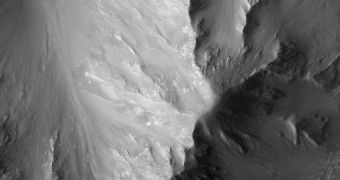The image above was collected by the High Resolution Imaging Science Experiment (HiRISE) instrument aboard the NASA Mars Reconnaissance Orbiter (MRO) at the end of January 2014. It shows a series of landscape features called recurring slope lineae (RSL) on the surface of Mars.
These geological formations are generally located on the north-facing slopes of Martian ridges. These particular structures can be found at a site called Coprates Chasma, which is a large ridge a short distance to the north from our neighboring world's equator.
HiRISE collected several images centered on this area, and mission controllers at NASA were recently able to stitch them together, forming a short animation that shows how the RSL change with the seasons. These features may be indicative of a past water cycle that may have existed on Mars billions of years ago.
The MRO arrived in orbit around Mars in 2006, and has been providing a wealth of data ever since. The mission has already sent more than 200 terabits of data back to Earth, and has provided relay services for missions such as Spirit, Opportunity, Curiosity, Phoenix Mars Lander and others.

 14 DAY TRIAL //
14 DAY TRIAL //